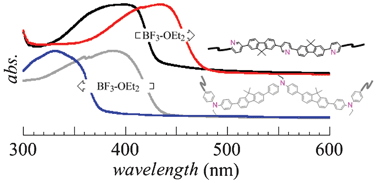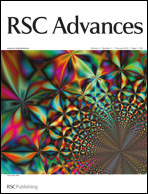We have demonstrated trifluoroborate-modification of both poly(2,6-pyridine-alt-9,9-dioctylfluorene-2,7-diyl) and poly(4,4′-diphenyl-N-hexylamine-alt-9,9-dioctylfluorene-2,7-diyl) (PPF and PAF, respectively) films to tune the electronic interactions and the mean conjugated lengths in the conjugated main segments. After BF3–OEt2 vapor treatment, both the absorption and fluorescence spectra of the PPF film were red-shifted due to the charge transfer interactions between the electron-accepting trifluoroborate-pyridine moiety and the weak electron-donating 9,9-dialkylfluorene unit. On the other hand, the transformation from an sp2- to an sp3-nitrogen in the main segment of the PAF film via Lewis acid (BF3–OEt2) vapor treatment resulted in a short mean conjugated length thus leading to a blue-shifted absorption band. Coordination between the BF3 and nitrogen moieties in the PPF and PAF films was successfully confirmed by high performance solid-state 19F MAS NMR spectroscopic measurements. The 5% weight loss decomposition temperatures of both unmodified and BF3-modified polymers were almost the same under nitrogen. After Lewis base (Et3N) vapor treatment to restore these modified polymer films to the unmodified films, the absorption and fluorescence bands of the PPF film blue-shifted and corresponded to that of the unmodified PPF. In contrast, the bands of the PAF film were red-shifted due to extension of the π-conjugated system by transforming from an sp3- to an sp2-nitrogen, and corresponded to that of the unmodified PAF film. It is noteworthy that the reversible process could be cycled many times.

You have access to this article
 Please wait while we load your content...
Something went wrong. Try again?
Please wait while we load your content...
Something went wrong. Try again?


 Please wait while we load your content...
Please wait while we load your content...